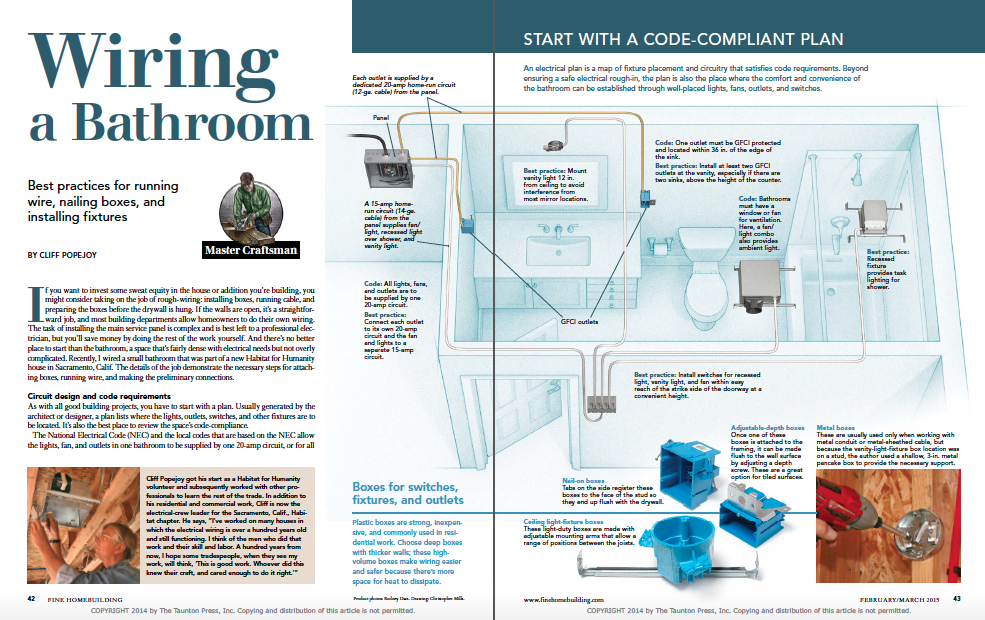What Are The Rules For Bathroom Wiring?
Bathroom wiring is a critical part of any home’s electrical system. It is important to follow the electrical code to ensure safety and prevent damage to the wiring and other electrical components. Bathroom wiring typically includes outlets, switches, lighting, and ventilation fans. The wiring should be installed professionally and should meet all local and national codes and regulations. Depending on the complexity of the project, it may be necessary to hire an electrician to ensure the wiring is installed properly. The following are the general rules for bathroom wiring:
1) Ensure the wiring is properly installed and secured. This includes properly secured wires, junction boxes, and outlets.
2) Make sure to use the correct size of wire for the job. Overloading the wire can cause a fire hazard.
3) Use Ground Fault Circuit Interrupter (GFCI) outlets for outlets located near water sources such as a bathtub or sink.
4) Install a dedicated circuit for bathroom lighting and ventilation fans.
5) Install all outlets and switches at least three feet away from the bathtub or shower.
6) Make sure all wiring is properly labeled and installed in an accessible area.
7) Inspect all wiring regularly to ensure it is not damaged or exposed.
Following these rules for bathroom wiring will help ensure a safe and efficient electrical system. It is also important to remember to contact a professional if you are unsure about any aspect of the wiring.
Overview of Bathroom Wiring
Bathroom wiring is a complex task, and it requires a certain set of rules to be followed in order to ensure safety and efficiency. It is important to understand the electrical codes and regulations that apply to bathroom wiring, as well as the best practices for wiring a bathroom. Knowing the right techniques for wiring a bathroom can help you avoid dangerous electrical fires and other safety hazards.
Before starting any bathroom wiring project, it is important to check local building codes to make sure you are aware of all the relevant regulations. To safely wire a bathroom, you will need to understand the types of wiring that are appropriate for different types of fixtures and appliances, and the correct way to install these wires. You will also need to consider the location of electrical outlets and switches, as well as how to run the wiring for new fixtures and appliances.
When wiring a bathroom, it is important to use the appropriate type of wire for the job. Common bathroom wiring includes 12-gauge or 14-gauge copper wire for the outlets and 20-amp circuits, and 14-2 or 14-3 wire for switches. In addition, all wiring should be enclosed in a metal or plastic conduit to protect it from moisture and other environmental factors.
Finally, it is important to ensure that all wiring is properly grounded. Grounding wires should be connected to the metal parts of the circuit, such as the light fixtures, outlets, and switches. This will help protect you from electrical shocks and provide an effective path for any electrical current to flow safely to the ground.
With the right knowledge and tools, it is possible to wire a bathroom safely and efficiently. Following the rules and regulations for bathroom wiring is essential for any homeowner or contractor to ensure a safe and productive wiring job.
Electrical Requirements for Bathroom Wiring
Bathrooms are one of the most important rooms in any home and the wiring within them requires special regulations to ensure safety. For the most part, the wiring rules for bathrooms are the same as for any room, but there are a few extra considerations that need to be taken into account. This article will outline the key rules for bathroom wiring, including GFCI outlets, ground fault circuit interrupters, and other regulations.
Firstly, all bathroom wiring must comply with the National Electrical Code (NEC). This code outlines specific requirements for wiring in bathrooms, such as the use of GFCI outlets, which are designed to reduce the risk of electrical shock. The NEC also requires that all bathroom wiring be properly grounded and that all outlets are properly labeled. In addition, all bathroom wiring must be protected by a circuit breaker.
When wiring a bathroom, it is important to make sure that all connections are secure and that all wires are properly insulated. Furthermore, it is recommended that all bathroom wiring be done by a professional electrician in order to ensure safety. In addition, all outlets should be tested regularly to ensure that they are working properly and that the circuit is not overloaded.
Finally, it is important to remember that proper safety protocols should be followed when working with bathroom wiring. This includes wearing safety glasses and gloves, avoiding contact with wires, and using a grounded power source. By following these rules, you can ensure that your bathroom wiring is safe and up to code.
Types of Bathroom Wiring
Bathroom wiring can be a complex task for even the most experienced do-it-yourselfer. It is important to know what type of wiring is necessary for the type of bathroom you are dealing with. There are a few different types of wiring that are typically used in bathrooms, such as combination wiring, GFCI wiring, and AFCI wiring. Each of these types of wiring has its own set of rules for installation and maintenance that need to be followed.
Combination wiring is a type of wiring that combines two or more electrical circuits in order to provide power to various fixtures and appliances in the bathroom. GFCI wiring is an extra layer of protection that is designed to protect people from shock and electrocution. GFCI wiring requires the installation of ground fault circuit interrupters (GFCI) in any area where water is present. AFCI wiring is designed to protect against electrical fires by detecting any arcing faults in the wiring.
No matter what type of wiring you choose for your bathroom, it is important to make sure that it is installed correctly and safely. It is important to adhere to the manufacturer’s instructions, local codes, and safety standards in order to ensure the safety of yourself and others. If you are unsure of how to wire a bathroom properly, it is best to consult a qualified electrician in order to ensure the job is done correctly.
Installing Bathroom Wiring
Bathroom wiring is one of the most important elements of any home’s electrical system. It is essential to understand the rules for bathroom wiring in order to ensure the safety of your family and your home. Installing bathroom wiring requires careful planning and attention-to-detail. Before beginning the project, you should determine the number of outlets, switches, and lights that you need to install. Depending on the size of your bathroom, you may also need to purchase additional wiring and electrical components.
Once you have determined the components needed, you will need to consult your local electrical code for specific guidelines. In most cases, bathroom wiring must be installed in accordance with the National Electrical Code. This code outlines the minimum requirements for electrical safety, and it is important to adhere to these standards when installing bathroom wiring. Additionally, you must install a ground fault circuit interrupter (GFCI) in order to protect users from electric shock.
When you are ready to begin installing the wiring, it is important to wear the appropriate safety gear. Additionally, you should turn off the power to the circuit that you are working on before starting. Next, carefully run the wiring from the breaker box to the outlets and switches. Once the wiring is installed, you can attach the outlets and switches to the wall, and then connect the wires to the outlets and switches. Finally, you can turn the power back on and test the wiring.
By understanding the rules for bathroom wiring and following the National Electrical Code, you can safely and successfully install bathroom wiring and protect your family from potential electrical hazards.

Safety Considerations for Bathroom Wiring
Bathroom wiring is an important part of the electrical system of any home, and it must be done properly to ensure the safety of all involved. When wiring a bathroom, it is important to adhere to building codes and electrical regulations to ensure that the wiring is safe and meets building code requirements. Several safety considerations must be taken into account when wiring a bathroom, including the type of wiring used, the number and location of outlets, and the installation of ground fault circuit interrupters (GFCIs).
The type of wiring used in a bathroom is determined by the local building codes and the type of fixtures in the area. Many bathrooms use metal conduit wiring, which is required for areas that are exposed to water or moisture. The number and location of outlets must also be taken into account when wiring a bathroom. Outlets must be placed in locations where they will not be exposed to water, and all outlets must be GFCI-protected.
Finally, ground fault circuit interrupters (GFCIs) must be installed in bathrooms to protect against electrical shock. GFCIs are designed to trip the circuit when an imbalance in the current is detected, which can prevent the potential for electrical shock. It is important to follow all of the safety considerations when wiring a bathroom, as the potential for electrical shock is high in these areas.
Common Mistakes to Avoid When Wiring a Bathroom
Bathroom wiring is an important part of any home repair or remodel project. While wiring a bathroom can seem intimidating, it’s actually a straightforward process. However, there are several rules and regulations you must follow to ensure the wiring is done safely and correctly. Knowing the rules for bathroom wiring and avoiding common mistakes can help you create a safe and functional bathroom.
When wiring a bathroom, you must first understand the National Electrical Code (NEC) requirements. The main rules for bathroom wiring involve safety, such as the use of ground fault circuit interrupters (GFCI) and insulated wires. Additionally, you should plan the wiring before beginning your project, and consider how the wiring will be connected to the rest of the home.
Another important rule is to avoid common mistakes when wiring a bathroom. For example, never overload circuits, use the right type of outlets, and never use extension cords. Additionally, use the correct size and type of wire for the application, and make sure all connections are secure. Finally, make sure to shut off the power before beginning any wiring work.
By understanding the rules for bathroom wiring and avoiding these common mistakes, you can safely and accurately wire a bathroom that meets all NEC requirements. With the right planning and preparation, you can ensure your bathroom is safe and functional for years to come.
Troubleshooting Bathroom Wiring Problems
In any home, bathroom wiring can be a complicated endeavor. Unfortunately, it’s a necessary task that requires a keen eye for detail and a comprehensive understanding of the electrical codes and regulations that govern your bathroom wiring system. Knowing the rules for bathroom wiring can be a great asset when it comes to troubleshooting any problems that may arise.
When it comes to bathroom wiring, the most important rule is to always ensure the wiring is installed properly and that all connections are secure. This means paying special attention to the National Electric Code (NEC) requirements for the type of wiring you’re installing. Additionally, it’s important to understand the specific electrical codes that apply to your area, as they can vary from state to state.
If you’re experiencing electrical issues in your bathroom, the next step is to troubleshoot the problem. First, check all the connections to make sure they are secure and in good condition. Then, double-check all your wiring to make sure it’s installed correctly and in accordance with the NEC. If these steps don’t solve your problem, it’s best to consult a professional electrician who can help you determine the cause and provide a safe, cost-effective solution.
By understanding the rules for bathroom wiring and knowing how to troubleshoot any issues that arise, you can ensure your bathroom is safe, efficient, and compliant with electrical codes. With the right knowledge and attention to detail, you can efficiently and effectively address any wiring issues that may arise in your bathroom.
Frequently Asked Questions About Bathroom Wiring
Bathroom wiring is one of the most complex and dangerous parts of any home electrical system, and it’s important to understand the rules and regulations before attempting any work. To help you get the job done safely and correctly, we’ve compiled a list of frequently asked questions about bathroom wiring. From the types of wiring available, to the safety regulations that must be followed, this comprehensive guide will help you understand the basics of bathroom wiring and ensure that the job is done right. We’ll also discuss the proper tools and materials to use, and the important safety tips that must be followed. So, if you’re ready to start wiring your bathroom, read on to learn the basics of bathroom wiring.
FAQs About the What Are The Rules For Bathroom Wiring?
1. Can I do bathroom wiring myself?
No, bathroom wiring must be installed by a qualified professional. It is important to ensure the wiring is done safely and meets all applicable electrical codes.
2. What code do I need to follow for bathroom wiring?
You must follow the national electrical code (NEC) for any type of bathroom wiring. Additionally, local codes may also apply depending on where you live.
3. What is the minimum wiring gauge for bathroom wiring?
The minimum wiring gauge for bathroom wiring is typically 14-gauge for lighting and 12-gauge for outlets. However, it is important to check your local codes for any additional requirements.
Conclusion
The rules for bathroom wiring can be complex and should always be done with the help of a qualified electrician. In general, all bathroom wiring must be done in accordance with local and national building codes. This means that all wiring must be done to the highest standards of safety and made to be resistant to moisture, heat, and other elements. Additionally, all electrical outlets must be installed with ground fault circuit interrupters to protect against shocks and potential injuries. Following these safety guidelines can help ensure a safe and properly functioning bathroom wiring system.






